Digital Posters
fMRI Clinical Applications: Unique Data Acquisition & Processing Methods
ISMRM & SMRT Annual Meeting • 15-20 May 2021

| Concurrent 5 | 17:00 - 18:00 |
1511.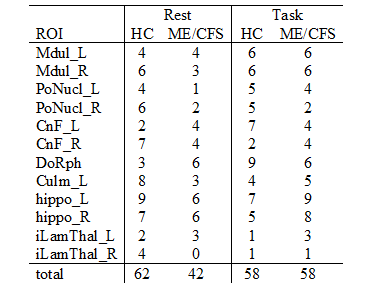 |
A survey of brainstem reticular activation system connectivity in myalgic encephalomyelitis / chronic fatigue syndrome (ME/CFS)
Leighton Barnden1, Sonya Marshall-Gradisnik1, Donald Staines1, and Zack Shan2
1Griffith University, Southport, QLD, Australia, 2University of Sunshine Coast, Sunshine Coast, QLD, Australia
For 44 ME/CFS and 26 HC, resting state and Stroop task fMRI were spatially normalized with a method optimized for the brainstem. After physiological signal (RETROICOR) denoising in CONN, BOLD correlations were computed between 12 brainstem reticular activation system (RAS) ROI seeds. A survey of connections showed fewer were significant in ME/CFS than HC at Rest, indicating impaired RAS function. During Task, although the same number of connections were active for the two groups, many were between different ROIs, suggesting compensatory mechanisms may be involved. Nerve signal conduction in the brainstem RAS was shown to be impaired in ME/CFS.
|
|||
1512.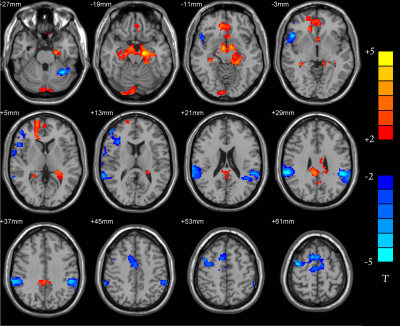 |
Evaluation of brain structure and function changed in vestibular migraine patients: a MRI MP2RAGE and SMS-Rs-fMRI study
Ya Guo1, Haihua Bao1, and Shaoyu Wang2
1Affiliated Hospital of Qinghai University, Xining, China, 2Siemens Healthineers, Shanghai, China
Headache caused by paroxysmal vestibular symptoms Known as vestibular migraine (VM), its pathophysiology and related mechanisms are less understood at this stage. The purpose of this study was to apply Simultaneous Multi-Slice Resting State functional Magnetic Resonance Imaging (SMS-Rs-fMRI) to explore the gray matter volume (GMV), brain function, and brain default in patients with VM..Compared with the control group, patients with VM had lower GMV in multiple brain areas, higher ALFF values in multiple brain areas, and changes in the brain default network function connection in the resting state.
|
|||
1513.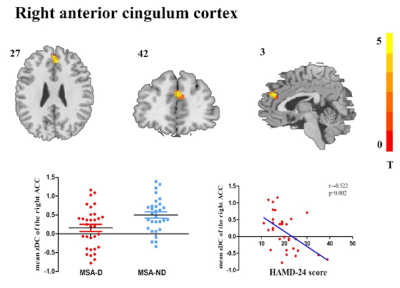 |
Altered voxel-level whole-brain functional connectivity in multiple system atrophy patients with depression symptoms
huaguang yang1, zhi Wen1, Lanhua Hu1, Weiyin Vivian Liu2, Guoguang Fan3, and Yunfei Zha1
1Radiology, Renmin Hospital of Wuhan University, Wuhan, China, 2MR Research, GE Healthcare, Wuhan, China, 3The First Affiliated Hospital of China Medical University, Shenyang, China
Depression is a common non-motor system symptom in patients with multiple system atrophy (MSA). Its pathogenesis is unknown. Multimodal functional magnetic resonance imaging (fMRI) is the main tool to explore the mechanism of pure depression and other diseases with depressive symptoms. Applications of fMRI on patients with MSA in accompanied with depressive symptoms is expected to reveal the difference to the MSA-involved depression mechanism different to the pure depression-involved brain network. Our results found altered secondary network in MSA patients with depression and provided a new idea for determination on treatments to MSA with depression. This study provided neuroimaging evidence for a clinical understanding of non-pure depression and possible reference for treatment measures.
|
|||
1514.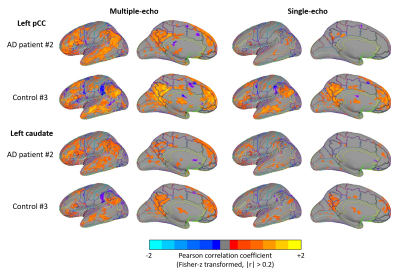 |
Potential Benefit of Multiband Multiecho EPI for Resting-state Functional MRI in Alzheimer's disease on a compact 3T system: A Preliminary study
Daehun Kang1, Myung-Ho In1, Erin Gray1, Thomas K Foo2, Radhika Madhavan2, Nolan K Meyer1, Lydia J Bardwell Speltz1, Zaki Ahmed1, Jeffrey Gunter1, Brice Fernandez3, Joshua D Trzasko1, John Huston1, Matt A Bernstein1, and
Yunhong Shu1
1Radiology, Mayo Clinic, Rochester, MN, United States, 2GE Global Research, Niskayuna, NY, United States, 3GE Healthcare, Buc, France
Using a high-performance gradient system, multi-band multi-echo fMRI with high temporal and spatial resolutions was acquired. The multi-echo images can be combined based on the weighting of local T2*. The echo-combination improves both the signal intensity and temporal SNR, particularly in regions suffering from signal dropout due to iron deposition like the basal ganglia. Also, the echo-combined images were demonstrated to be superior to the single-echo images for studying functional connectivity due to increased BOLD contrast sensitivity. Multi-echo fMRI is particularly promising for studies of aging and dementia as iron deposition and brain atrophy confound analyses.
|
|||
1515.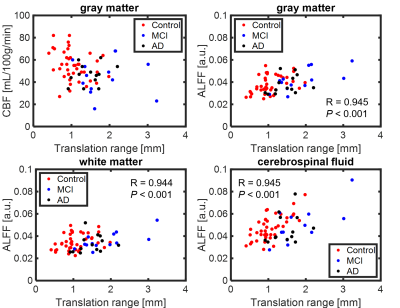 |
Evaluation and interaction of disease dependent head motion, low frequency oscillations, and cerebral blood flow in Alzheimer’s Disease cohort
Mu-Lan Jen1, Laura B. Eisenmenger2, Sterling C. Johnson3,4, Veena A. Nair2, Vivek Prabhakaran2, and Kevin M. Johnson1,2
1Medical Physics, University of Wisconsin-Madison, Madison, WI, United States, 2Radiology, University of Wisconsin-Madison, Madison, WI, United States, 3Geriatric Research Education and Clinical Center, William S. Middleton Memorial Veterans Hospital, Madison, WI, United States, 4Wisconsin Alzheimer's Disease Research Center, University of Wisconsin-Madison, 53705, WI, United States
Recent studies have suggested reduced altered low-frequency oscillations (LFOs) and cerebral blood flow (CBF) in subjects with Alzheimer’s disease (AD). These measures may reflect reduced neural activity and altered waste clearance but are subject to confounding effects from patient motion. This study of a cohort of AD and controls investigates interaction of patient motion with LFO from BOLD and CBF from multi-delay arterial spin labeling. Results demonstrate significantly increased motion in subjects with AD and a correlation of motion estimates with BOLD LFO but not with CBF. These results suggest motion should be considered for studies in neurodegenerative subjects.
|
|||
1516.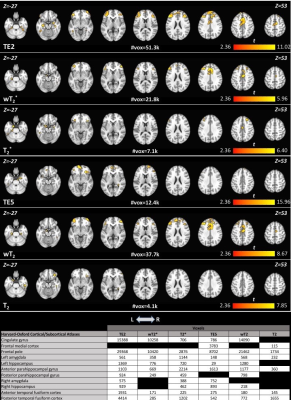 |
Implementation of multi-contrast, multi-echo SAGE-fMRI in aging and Alzheimer’s disease
Elizabeth G. Keeling1,2, Maurizio Bergamino1, Lori Steffes1, Anna Burke3, and Ashley M. Stokes1
1Division of Neuroimaging Research, Barrow Neurological Institute, Phoenix, AZ, United States, 2School of Life Sciences, Arizona State University, Tempe, AZ, United States, 3Division of Neurology, Barrow Neurological Institute, Phoenix, AZ, United States
The purpose of this study was to apply a previously developed multi-contrast, multi-echo sequence using spin- and gradient-echo (SAGE) for fMRI in the context of Alzheimer’s disease (AD). We acquired pilot SAGE-fMRI data with five echoes (2 gradient-echoes, 2 asymmetric spin-echoes, 1 spin-echo) using episodic memory encoding and retrieval tasks in healthy aging and cognitively impaired (mild cognitive impairment (MCI) or mild AD) cohorts. Group differences in task-related activation were evaluated across single echo and multi-echo combined dynamic SAGE signals. SAGE-fMRI contrasts showed promise for more robust distinction between HC and CI groups than single-echo fMRI in AD-relevant brain regions.
|
|||
1517.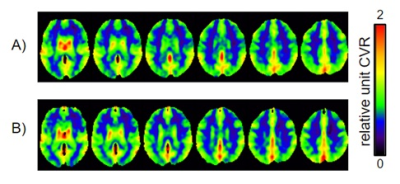 |
Machine learning classifiers on resting-state cerebrovascular reactivity in preclinical Alzheimer's disease
Kaio Felippe Secchinato1, Pedro Henrique Rodrigues da Silva1, Júlia Palaretti1, and Renata Ferranti Leoni1
1Departamento de Física, University of São Paulo, Ribeirão Preto, Brazil
Early detection of Alzheimer's disease (AD) increases the treatment benefits. However, it is still a challenging question which biomarkers are useful for early diagnosis. Then, we aimed to classify cognitively normal elderly regarding the possibility to develop AD based on resting-state cerebral vasoreactivity (CVR) values and neuropsychological (NP) scores. We used supervised machine learning algorithms. Our results suggest that Random Forest and K-Nearest Neighbors classifiers trained with CVR values of the vermis.7 (part of the cerebellum), and left parahippocampal gyrus, and Mini-Mental State Examination (MMSE), and Trail Making Test A scores can be useful on the early detection of AD.
|
|||
1518.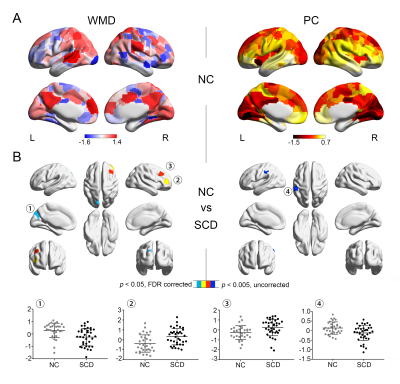 |
Community-informed connectomics of cortical intrinsic organization in participants with subjective cognitive decline
Qian Chen1, Jilei Zhang2, and Bing Zhang1
1Department of Radiology, Drum Tower Hospital, Clinical College of Nanjing Medical University, Nanjing, China, 2Philips Healthcare, Shanghai, China
Individuals with subjective cognitive decline (SCD) were at higher risk of Alzheimer’s disease. Based on community-informed connectome analysis, we observed decreased intra-module connectivity in superior occipital gyrus of the visual network and decreased inter-module connectivity in supramarginal gyrus of the dorsal attention network in SCD subjects. The SCD group also showed increased intra-module connectivity in the dorsolateral prefrontal cortex and middle frontal gyrus of the frontoparietal network. The altered network measures showed significant correlations with cognitive performance on memory and language. Our findings may benefit a better understanding of the neural basis underlying early cognitive decline in the SCD stage.
|
|||
1519. |
Network evolution of patients with Alzheimer via graph theory
Mohsen Mazrooyisebdani1,2, BARBARA B BENDLIN3, Shi-Jiang Li4, and Vivek Prabhakaran1,5,6
1Radiology Department, University of Wisconsin Madison, Madison, WI, United States, 2Electrical and computer Engineering, University of Wisconsin Madison, Madison, WI, United States, 3Department of Medicine, University of Wisconsin Madison, Madison, WI, United States, 4Department of Biophysics, University of Wisconsin Madison, Madison, WI, United States, 5Neuroscience Training program, University of Wisconsin Madison, Madison, WI, United States, 6Medical Scientist Training Program, University of Wisconsin Madison, Madison, WI, United States
This abstract presents an evaluation of alteration in the functional brain network of patients with Alzheimer’s disease (AD) with a focus on the application of graph theory as a pure data-driven analysis approach. The main goal in this work is to diagnose any potential biomarker of Alzheimer’s disease in the brain connectivity network of patients.
|
|||
1520.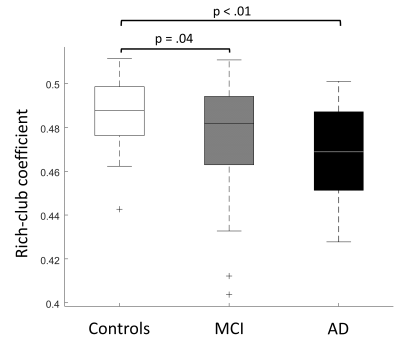 |
Rich-club connectivity of the structural covariance network is reduced in mild cognitive impairment and Alzheimer’s disease
Gerhard Drenthen1, Walter Backes1, Whitney Freeze1, and Jacobus Jansen1
1Maastricht University Medical Center, Maastricht, Netherlands
A reduced rich-club connectivity of the structural covariance network was found in individuals with MCI and AD compared to controls. Moreover, we show that a loss of connections in the rich-club subnetwork may form a mechanism underlying memory loss in the context of MCI and dementia.
|
|||
1521.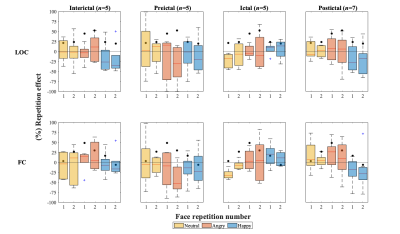 |
BOLD-fMRI repetition suppression versus enhancement: assessing habituation to emotional faces through the migraine cycle
Catarina Domingos1, Amparo Ruiz-Tagle1, Ana Fouto1, Inês Esteves1, Raquel Gil-Gouveia2, and Patrícia Figueiredo1
1Institute for Systems and Robotics - Lisboa and Department of Bioengineering, Instituto Superior Técnico, Universidade de Lisboa, Lisbon, Portugal, 2Neurology Department, Hospital da Luz, Lisbon, Portugal
We investigated habituation in migraine, by measuring repetition effects to emotional faces using BOLD-fMRI, during all phases of the migraine cycle. We first performed simulations to determine the sensitivity of the proposed fMRI paradigm and respective BOLD deconvolution approach to detect repetition effects, and then applied this to real data. Simulations showed that a commonly used deconvolution approach was able to correctly estimate repetition effects provided that response delays did not significantly deviate from default. When applied to real data, we found that controls exhibited the normal repetition suppression, but patients exhibited response maintenance or even potentiation.
|
|||
1522.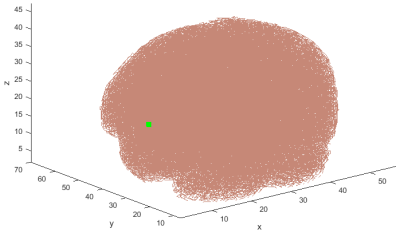 |
Adaptive space-filling curve for improved feature selection from fMRI brain activation maps: application to schizophrenia classification
Unal Sakoglu1, Lohit Ravi Teja Bhupati2, Olexandra Petrenko1, and Vince D Calhoun3
1Computer Engineering, University of Houston - Clear Lake, Houston, TX, United States, 2Computer Science, University of Houston - Clear Lake, Houston, TX, United States, 3Center for Translational Research in Neuroimaging and Data Science (TReNDS), Atlanta, GA, United States
In this work, we develop a 3D to 1D ordering methodology for fMRI data, using a new space filling curve (SFC), which is adaptive to brain's shape based on T1 MRI. We apply this SFC ordering to fMRI activation maps from a schizophrenia study, compress/bin the data, obtain features, and perform classification of schizophrenia vs normal controls. The classification results using SFC ordering are superior to those using linear ordering, the traditional method.
|
|||
1523.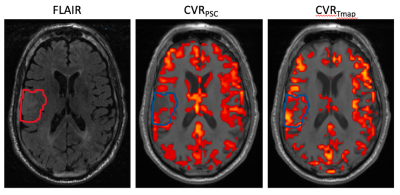 |
Data-driven analysis of Cerebrovascular Reactivity Mapping with Breath-Hold BOLDMRI in Patients with gliomas
Mei-Yu Yeh1,2, Ping Hou2, and Ho-Ling Liu 2
1Department of Biomedical Engineering and Environmental Sciences, National Tsing Hua University, Hsinchu, Taiwan, 2Department of Imaging Physics, The University of Texas MD Anderson Cancer Center, Houston, Houston, TX, United States
Cerebrovascular reactivity (CVR) mapping can be achieved by BOLD MRI during hypercapnia challenges, such as a breath-hold (BH) task. It has wide applications for the assessment of various neurological deficits and neurovascular uncoupling. The BH MRI is typically analyzed by modeling with a hemodynamic or respiratory response function and account for latencies in signal time courses. Accurate modeling requires physiological monitoring and/or consistent patient performance during the scan. Because the BOLD signal response to the BH is a global effect, this study proposes to utilize the individual’s whole-brain signal average as a regressor for the analysis of BH MRI.
|
|||
1524. |
Correlations analysis between changes in longitudinal ALFF and ReHo values of methamphetamine abstinence subjects and behavioral tests BIS-11
Yanyao Du1, Ru Yang1, Wenhan Yang1, Huiting Zhang2, and Jun Liu1
1Department of Radiology, the Second Xiangya Hospital of Central South University, Changsha, China, 2MR Scientific Marking, Siemens Healthcare Ltd., Wuhan, China This study aimed to evaluate the correlation of longitudinal changes of amplitude low-frequency fluctuation (ALFF) and regional homogeneity (ReHo) values based on Harvard-Oxford atlas (HOA) and Barratt Impulsivity Scale 11 (BIS-11) in subjects with methamphetamine abstinence. The results suggested that there were significant positively correlations between right middle frontal gyrus (8) and BIS total scores, BIS attention scores as well as BIS non-planning score. |
|||
1525.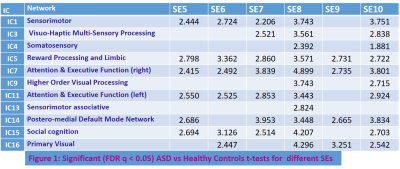 |
Oxytocin function regulation in autism spectrum disorders probed with rsfMRI complexity analysis
Kaundinya Gopinath1, Elissar Andari1, and Larry Young1
1Emory University, Atlanta, GA, United States
Autism spectrum disorders (ASD) are characterized by dysregulation of endogenous oxytocin (OXT) function. In this study, we employed complexity of resting state fMRI signal as a tool to examine: 1) brain function impairments in adult ASD, 2) the relationship between DNA methylation of OXT receptor gene and severity of cognitive impairment, and 3) the effects of intranasal OXT treatment (IN-OXT). ASD patients exhibited abnormally increased fMRI signal complexity in a number of brain function networks. The severity of these impairments were inversely related to DNA methylation levels. IN-OXT attenuated impairments in these networks. Thus, OXT has neuroprotective effects in ASD.
|
|||
1526.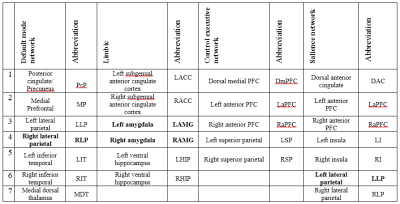 |
Altered Large-Scale Brain Networks in Mesial Temporal Lobe Epilepsy Based on Dynamic Causal Modeling
Alireza Fallahi1, Fatemeh Salimi2, Fatemeh Eyvazi3, Narges Hosseini Tabatabaei4, Mohammad-Reza Ay2, and Mohammad-Reza Nazem-Zadeh2
1Shahed University, Tehran, Iran (Islamic Republic of), 2Tehran University of Medical Sciences, Tehran, Iran (Islamic Republic of), 3Institute for cognitive science studies, Shahid Beheshti University, Tehran, Iran (Islamic Republic of), 4Brain and Spinal Cord Injury Research Centre, Neuroscience Institute, Tehran University of Medical Sciences, Tehran, Iran (Islamic Republic of)
In this study, dynamic causal modeling (DCM) was applied to resting state fMRI data of mesial temporal lobe epilepsy (mTLE) patients to determine the directional alternations in effective connectivity in large scale brain networks. We hypothesized that mTLE alters the functional connectivity in both temporal and extra-temporal functional brain networks. We further hypothesized that the altered connectivity is directional (The direction between two network nodes matters). The results showed significantly different effective connectivity in default mode, limbic and salience networks.
|
|||
1527.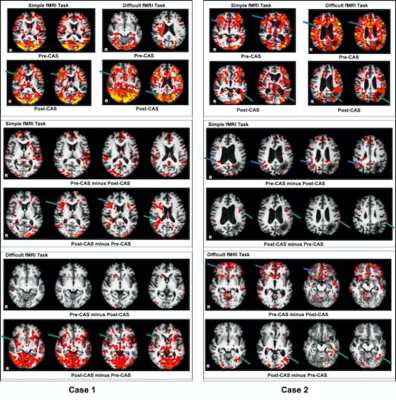 |
Task-phase fMRI evidencing cognitive improvement post carotid angioplasty and stenting (CAS) – initial findings of a follow-up study
Betty Chinda1,2, Simon Liang3, William Siu4, George Medvedev5, and Xiaowei Song1,2
1Department of Biomedical Physiology & Kinesiology, Simon Fraser University, Burnaby, BC, Canada, 2Health Research and Innovation, Fraser Health Authority, Surrey, BC, Canada, 3Department of Medicine, University of British Columbia, Vancouver, BC, Canada, 4Department of Radiology, Royal Columbian Hospital, New Westminster, BC, Canada, 5Department of Neurology, Royal Columbian Hospital, New Westminster, BC, Canada
This longitudinal task-phase fMRI study aims to provide direct evidence of possible effects of Carotid angioplasty and stenting (CAS) on cognition. The initial phase enrolled patients with severe carotid stenosis (≥70% stenosis) who had MRI scans pre-CAS and two-month post-CAS. At each scan, patients completed two fMRI sessions while performing a working memory task. Improved cerebral perfusion to areas supplied by carotid arteries following CAS was correlated with improved cognitive function in working memory performance along with increased fMRI activations in the re-perfused vascular territory especially in frontal and temporal lobes and reduced in the contralateral hemisphere.
|
|||
1528.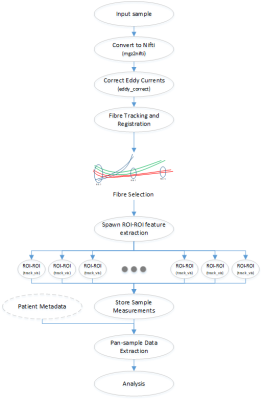 |
A Generalized Tool for Deriving Connectomes in Support of Computational Neuroscience
David Mattie1, Zihang Fang2, Emi Takahashi2,3, and Jacob Levman1
1Bioinformatics Group, St. Francis Xavier Unversity, Antigonish, NS, Canada, 2Department of Medicine, Boston Children’s Hospital, Boston, MA, United States, 3Department of Pediatrics, Harvard Medical School, Boston, MA, United States
Identifying regional neural pathways with magnetic resonance imaging (MRI) based diffusion characteristics across all possible regions of interest (ROI) is computationally expensive and demands a concerted effort to ensure reliable extraction of tractography statistics from the diffusion tensor imaging data associated with identifiable fiber tracts from a patient’s brain MRI examination. Here we present a software tool called Connectome Reporting User Shell (CRUSH) that processes DTI data using pluggable modules that can be tailored to research specific outcomes. We demonstrate the value of such a tool by conducting a whole-brain tractography-based connectomics analysis on a clinically imaged neurologically healthy population.
|
|||
1529.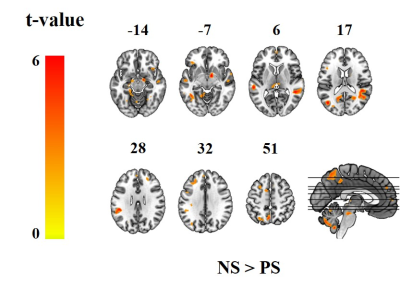 |
The Neural Activation of Positive versus Negative Though-Action Fusion: an fMRI study
Hyunsil Cha1, Sang Won Lee2, Heajeong Choi1, Eunji Kim1, Seungho Kim1, Yunheung Kim1, Seung Jae Lee2, and Yongmin Chang3
1Medical and Biological Engineering, Kyungpook National University, Daegu, Korea, Republic of, 2Department of Psychiatry, Kyungpook National University Hospital, Daegu, Korea, Republic of, 3Radiology and Molecular Medicine, Kyungpook National University, Daegu, Korea, Republic of
In this fMRI study, we aimed to investigate the neural circuits related to positive and negative TAF by using a modified TAF task, wherein individuals were asked to read the name of a close person within positive or negative statements.
|
|||
1530.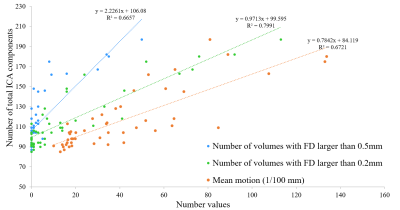 |
Influence of head motion on the output of Independent Component Analysis (ICA)-based denoising of task-related fMRI data at 7T
Thuy Ha Duy Dinh1, Koji Fujimoto1, Thai Akasaka1, Tadashi Isa1, and Tomohisa Okada1
1Human Brain Research Center, Kyoto University, Kyoto, Japan
Head motion during the acquisition of fMRI data can significantly contaminate the neural signal and induce spurious, distance-dependent changes in signal correlations. Framewise displacement (FD) has often been used as a cut-off threshold for removing bad fMRI datasets related with high motion. Here we investigated the influence of head motion on the output of ICA-based denoising analysis. The results showed a strong correlation between the number of total ICA components with head mean motion and FD, which indicated that the number of ICA components can be an index for detecting high motion-related fMRI datasets.
|
The International Society for Magnetic Resonance in Medicine is accredited by the Accreditation Council for Continuing Medical Education to provide continuing medical education for physicians.